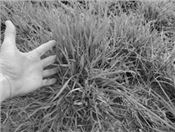Moving Your Pasture Toward The Desired Forage Species

Nitrogen deficiencies are not always clearly visible. Orchardgrass will develop a yellowish tint that indicates need to nitrogen fertilization.
U of A System Division of Agriculture photo by Dirk Philipp
FAYETTEVILLE, ARK.
Over time, changes in grazing habits, fertility and plant age can prompt changes in the composition of pastures. There are, however, ways to maintain a desired forage for as long as possible, said Dirk Philipp, associate professor-animal science, for the University of Arkansas System Division of Agriculture.
“Whenever we talk about a ‘fescue pasture’ or ‘bermudagrass pasture’ we actually know that those forages never occur at a 100 percent level in a perennial pasture,” he said. “Most of the time they may be prevalent at 70-80 percent or less, with the remainder being covered by undesired plants or even other forages.”
Philipp said there are a few major forages in Arkansas and these “are arguably tall fescue, bermudagrass, and increasingly native forages and pastures consisting of big bluestem-indiangrass mixes or other prairie-type vegetation, and perhaps some orchardgrass as well.”
However, “over time, species composition always shifts in pastures, depending on the age of forage base, history of weed control and management,” Philipp said.
“Species composition shifts naturally based on rainfall distribution, temperature and other factors, but depending on management style, certain processes are being enhanced or impeded,” Philipp said. “If pH is low then certain plants are favored since domesticated food and forage plants work in a fairly narrow window of near-neutral pH and good soil fertility. If pH drops, then certain soil minerals may become less available and more adapted plants thrive.”
Other factors influencing change in a pasture include grazing.
“Overgrazing is by far the major source of species composition shifts. It literally opens up space for other plants to populate weak spots in a pasture,” he said.
Keeping your forage going
Philipp said fertilizing, managing mowing/grazing and weed management are all keys to keeping a desired forage composition stable.
Fertilize cool-season perennial grasses on a regular basis.
“Tall fescue and in particular orchardgrass respond well to nitrogen fertilizer, provided other macronutrients such as phosphorus and potassium are kept in reasonable ranges as well,” he said. “Both grasses benefit from 60 pounds of nitrogen in spring and then again in fall.”
Philipp said a producer probably won’t see much difference by skipping fertilizer for one year on grazed pastures, “but you definitely will the following year by seeing more weeds, a weaker stand and less growth.”
Low-growing forages such as fescue and orchardgrass have a decisive disadvantage compared with weeds: their low canopy height.
“Many weeds such barnyardgrass, goose grass and pigweed are plants that grow as tall or even taller, so your forage will need all the help to grow tall,” he said. “Yes, the weeds are happy about the nitrogen too, but weeds are much more adapted to low-fertility conditions.”
Mowing/grazing
Fescue and orchardgrass are bunch grasses that shouldn’t be grazed completely into the ground repeatedly.
“’Take half, leave half’ sounds rather crude, but it is actually a good rule of thumb for managing these grasses,” Philipp said.
“These grasses also have a relatively large leaf area that is crucial for rapid regrowth. The more leaf area remains after a grazing event, the more rapidly these grasses will recover.”
On the other hand, bermudagrass pastures can be pushed towards cleaner stands by mowing on a set schedule at a relatively low cutting height.
“Bermudagrass withstands lower mowing or grazing heights and actually becomes more competitive because other undesired plants and weeds may not be as tolerant to low, repeated cutting,” Philipp said.
“Native warm-season grasses, in turn, have to be grazed very carefully as the window is very narrow, just from mid-May to the end of August,” he said. “These grasses should not be grazed down below 6 inches and therefore have to be rotationally stocked to remove animals quickly once this grazing height is reached.”
Weed management
“I’ll say it again, control weeds on time! This cannot be overstressed,” Philipp said.
“Weeks matter. For example, if you cannot spray dormant bermudagrass pastures by early- to mid-March, the ship has sailed for the year,” he said. “Weed plants have to be growing for good herbicide efficacy but pay attention to optimum growth stages and height as specified for effective herbicide application.” ∆